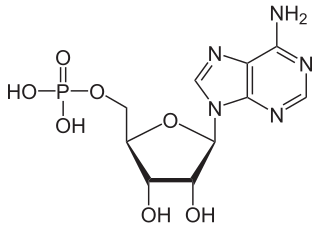
Adenosine monophosphate (AMP), also known as 5'-adenylic acid, is a nucleotide. AMP consists of a phosphate group, the sugar ribose, and the nucleobase adenine. It is an ester of phosphoric acid and the nucleoside adenosine. As a substituent it takes the form of the prefix adenylyl-.
Translocase is a general term for a protein that assists in moving another molecule, usually across a cell membrane. These enzymes catalyze the movement of ions or molecules across membranes or their separation within membranes. The reaction is designated as a transfer from “side 1” to “side 2” because the designations “in” and “out”, which had previously been used, can be ambiguous. Translocases are the most common secretion system in Gram positive bacteria.
Carbamoyl phosphate synthetase (glutamine-hydrolysing) is an enzyme that catalyzes the reactions that produce carbamoyl phosphate in the cytosol. Its systemic name is hydrogen-carbonate:L-glutamine amido-ligase .
Purine metabolism refers to the metabolic pathways to synthesize and break down purines that are present in many organisms.
In enzymology, an aerobactin synthase (EC 6.3.2.39) is an enzyme that catalyzes the chemical reaction
In enzymology, a beta-glucan-transporting ATPase (EC 3.6.3.42) is an enzyme that catalyzes the chemical reaction
In enzymology, a glycerol-3-phosphate-transporting ATPase (EC 3.6.3.20) is an enzyme that catalyzes the chemical reaction
In enzymology, a guanine-transporting ATPase (EC 3.6.3.37) is an enzyme that catalyzes the chemical reaction
In enzymology, a heme-transporting ATPase (EC 3.6.3.41) is an enzyme that catalyzes the chemical reaction
In enzymology, a manganese-transporting ATPase (EC 3.6.3.35) is an enzyme that catalyzes the chemical reaction
In enzymology, a Mg2+-importing ATPase (EC 3.6.3.2) is an enzyme that catalyzes the chemical reaction
In enzymology, a monosaccharide-transporting ATPase (EC 3.6.3.17) is an enzyme that catalyzes the chemical reaction
In enzymology, a Na+-exporting ATPase (EC 3.6.3.7) is an enzyme that catalyzes the chemical reaction
In enzymology, a Na+-transporting two-sector ATPase (EC 3.6.3.15) is an enzyme that catalyzes the chemical reaction
In enzymology, a peptide-transporting ATPase (EC 3.6.3.43) is an enzyme that catalyzes the chemical reaction
In enzymology, a peroxisome-assembly ATPase (EC 3.6.4.7) is an enzyme that catalyzes the chemical reaction
In enzymology, a phosphate-transporting ATPase (EC 3.6.3.27) is an enzyme that catalyzes the chemical reaction
In enzymology, a vitamin B12-transporting ATPase (EC 3.6.3.33) is an enzyme that catalyzes the chemical reaction
In enzymology, a xenobiotic-transporting ATPase (EC 3.6.3.44) is an enzyme that catalyzes the chemical reaction
Cobyrinate a,c-diamide synthase (EC ), cobyrinic acid a,c-diamide synthetase, CbiA (gene)) is an enzyme which catalyses the chemical reaction

